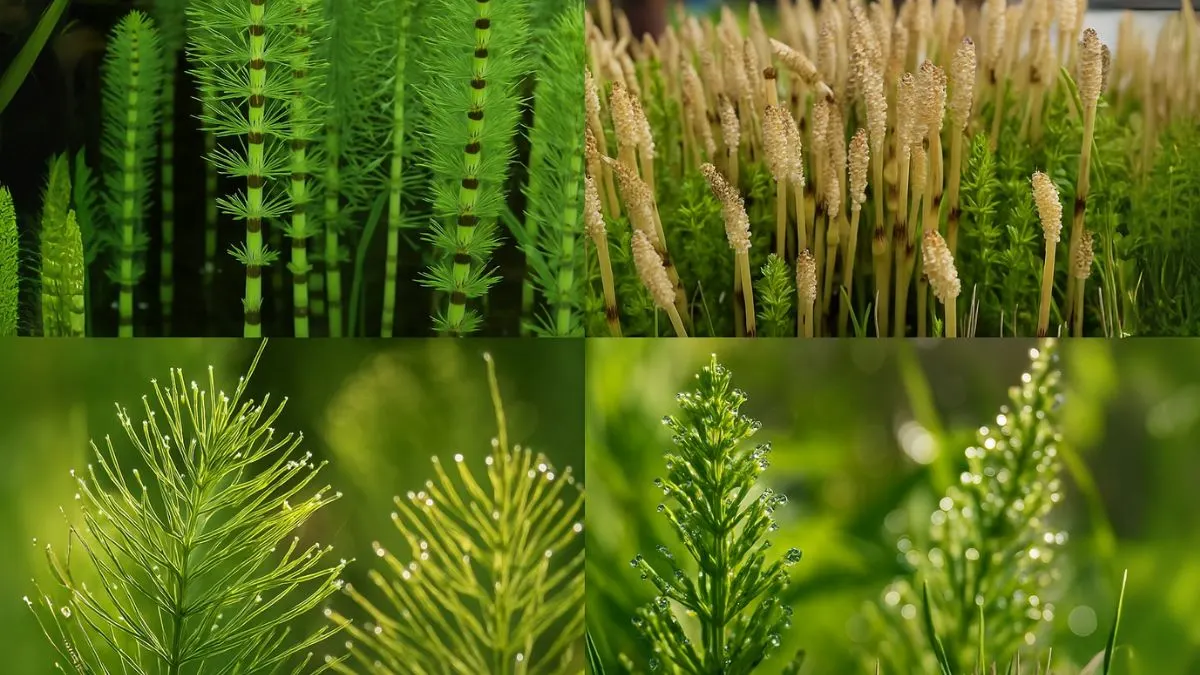Imagine a plant that has survived since the time of the dinosaurs. That’s the story of the horsetail plant. Belonging to the genus Equisetum, horsetails are considered living fossils because they represent some of the oldest surviving plant species on Earth.
Though they are ancient, they’re still present in modern landscapes across the USA, Canada, and the UK, making them both historically significant and ecologically relevant.
Classification: Where Horsetails Belong

- Equisetum is a group of plants categorized as a fern, though they look nothing like the feathery ferns we commonly see.
- They are primitive, non-flowering perennial plants once grown for ornamental purposes, surviving mostly through spores rather than seeds.
- Fossils show that horsetails were once massive tree-like species dominating prehistoric forests.
Today, they exist in smaller, herbaceous forms but still carry the same structural characteristics that make them unique.
Key Characteristics of Horsetail Plants
Horsetails are a very easily recognized group of plants because of their unusual jointed stems and lack of flowers.
- Scientifically, they are described as fifteen species of rushlike conspicuously jointed perennial herbs.
- The stems are hollow, ribbed, and rough, often resembling bamboo in miniature form.
- Leaves are reduced to small, scale-like structures arranged in whorls at each joint.
Here’s a quick summary table:
Feature |
Description |
Genus |
Equisetum |
Growth Form |
Prehistoric, non-woody herbaceous plants |
Reproduction |
Spores, not seeds |
Stems |
Hollow, jointed, rough |
Leaves |
Reduced, scale-like, arranged in whorls |
Also Read: Step-by-Step Guide to Caring for Your Christmas Cactus at Home
Horsetail in the UK and Beyond
The horsetail is a prehistoric perennial native to the UK, where it thrives in damp soils, riverbanks, and meadows. However, it is equally widespread across Europe, Asia, North America, and even parts of Africa.
In Canada and the USA, gardeners often battle horsetail as a persistent weed because of its deep-rooted rhizomes. Despite being invasive in some regions, it remains valued in herbal medicine and soil restoration projects.
Common Horsetail: Two Types of Stems
One unique feature is that the common horsetail consists of two types of stems:
- Fertile Stems – These appear first in spring, short and brown with cone-like structures at the tips that release spores.
- Sterile Stems – These appear later, tall and green, photosynthetic, and resemble tiny bamboo canes.
This two-stem strategy sets horsetails apart from most other plants, giving them a fascinating life cycle.
Why Horsetails Are Considered Primitive
- They are prehistoric, non-woody herbaceous plants that reproduce through spores, not seeds or flowers.
- Being primitive, non-flowering perennial plants once grown for ornamental purposes, horsetails showcase plant evolution at its simplest.
- Their silica-rich stems once made them useful as natural scouring pads for cleaning pots and pans, earning them the nickname “scouring rush.”
In my personal experience, I once encountered horsetails along a stream in Ontario, Canada. At first glance, I mistook them for baby bamboo shoots. Only later did I realize I was looking at a plant that has existed for over 100 million years!
Also Read: From Poinsettias to Holly: Gorgeous Christmas Plants for Your Home
Horsetails as Ornamental and Medicinal Plants
Historically, horsetails were once grown for ornamental purposes in gardens, thanks to their structural appeal. They bring a prehistoric vibe to landscaping, making them interesting accent plants.
Beyond looks, horsetails are also valued for their medicinal use. Rich in silica, they are believed to strengthen hair, nails, and bones. Herbal teas made from horsetail extracts are still popular in many cultures.
Global Significance of Equisetum
- In Canada and the USA, horsetails are both admired and dreaded—admired for their unique beauty, dreaded for their invasive tendencies.
- In the UK, the horsetail is a prehistoric perennial native to wetlands and woodlands.
- Globally, horsetails continue to be studied for their evolutionary importance as some of the oldest vascular plants still alive today.
Common Mistakes When Dealing with Horsetail
- Confusing it with bamboo or grasses – While it looks similar, horsetail belongs to Equisetum, a fern relative.
- Trying to eradicate it without patience – Its deep rhizomes make it one of the hardest plants to remove once it invades gardens.
- Underestimating its spread – It thrives in poor soils where many plants fail, making it resilient but difficult to control.
Also Read: Indoor Succulents: Care, Watering, Light & Secrets You Must Know
Horsetails—Ancient Plants in a Modern World
To sum up, horsetails are:
- Members of the Equisetum genus.
- Fifteen species of rushlike conspicuously jointed perennial herbs.
- Prehistoric, non-woody herbaceous plants that reproduce through spores.
- The common horsetail consists of two types of stems.
- Primitive, non-flowering perennial plants once grown for ornamental purposes.
Their survival story makes them one of nature’s most fascinating relics. From prehistoric forests to modern UK wetlands, horsetails remain a very easily recognized group of plants.
👉 Next time you spot one, remember—you’re looking at a living piece of Earth’s history.






